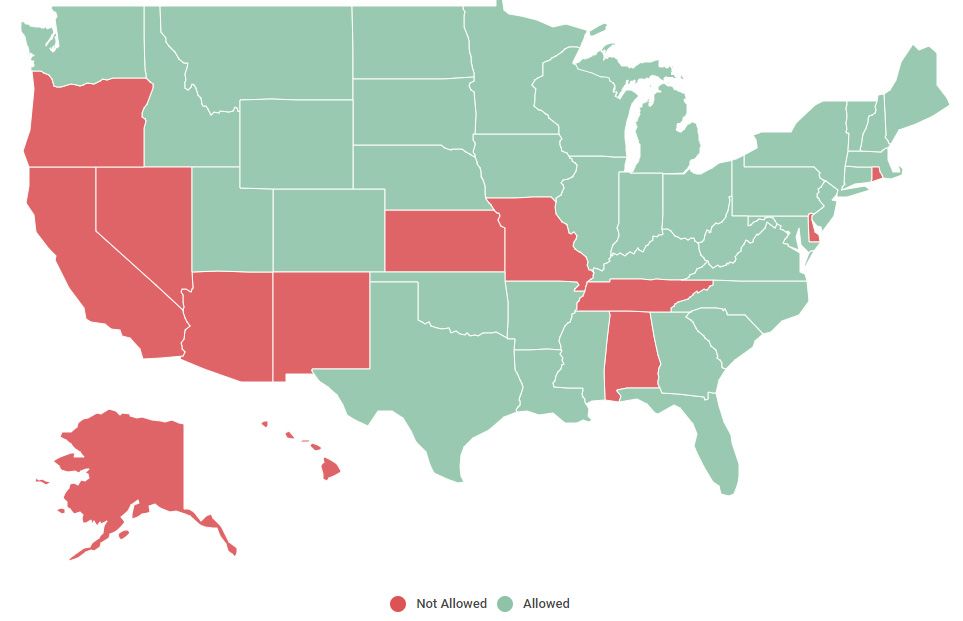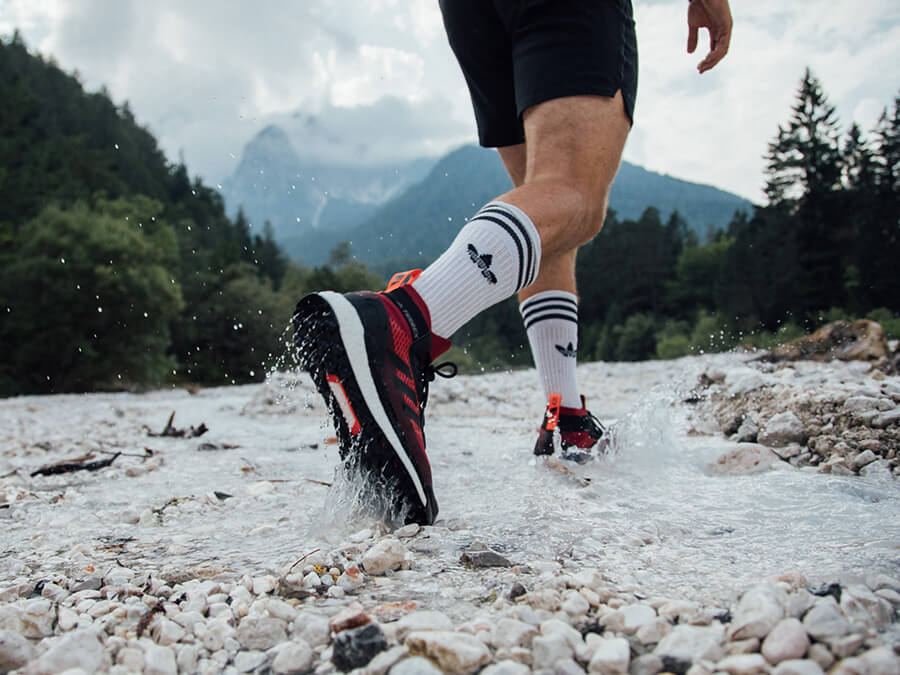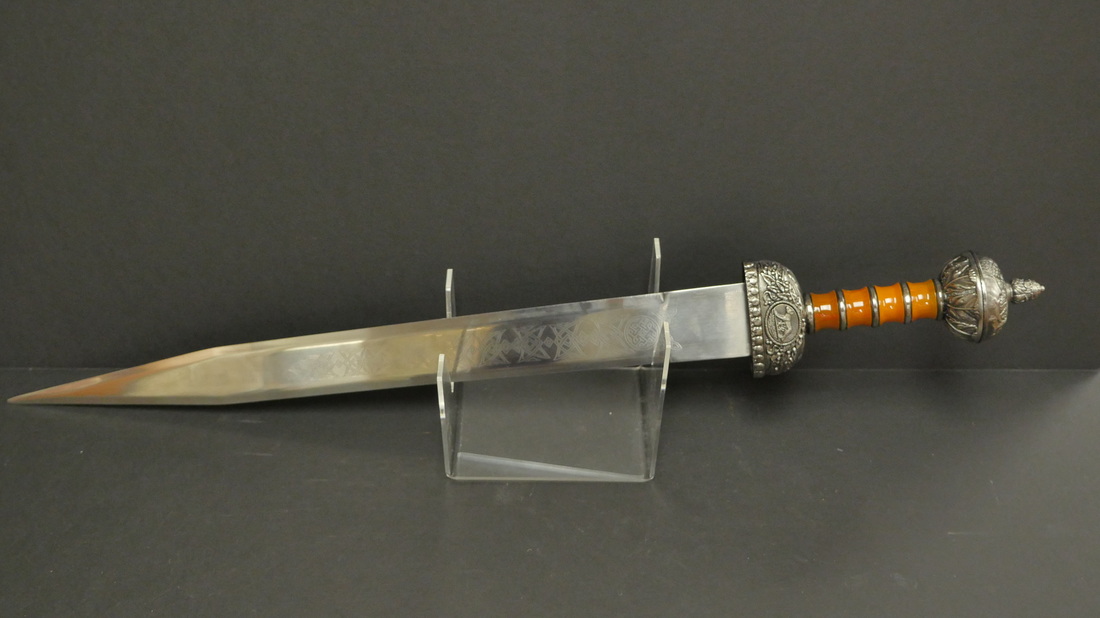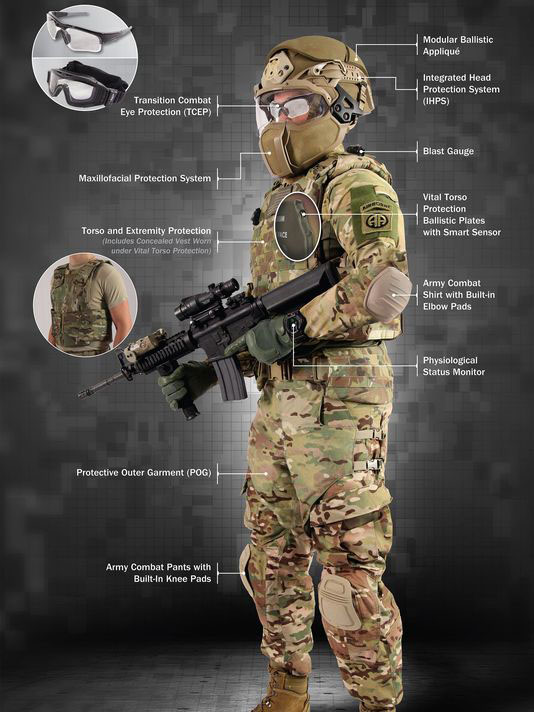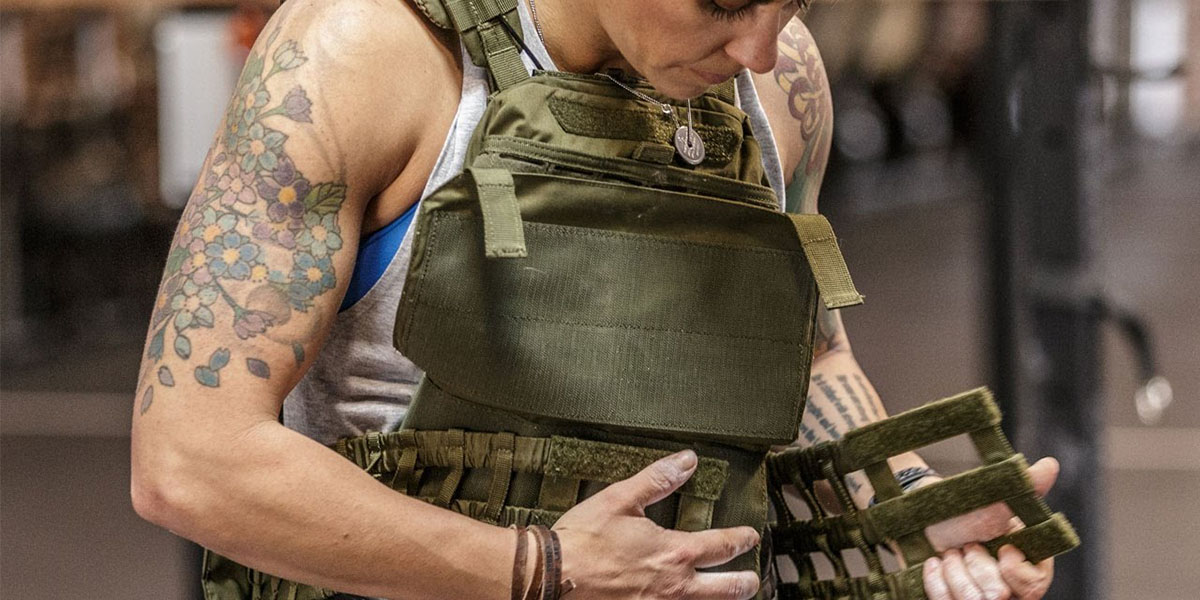If things get really bad, like a sudden epidemic outbreak, it’s reasonable to think you are at risk of being attacked by other people — let alone in more common emergencies like active shooters and home defense.
As part of the “create holes, prevent holes, plug holes” framework of emergency combat, body armor is a core component of protecting yourself and preventing holes.
To narrow down our recommended choices of the best bulletproof body armor for preppers, we spent over 100 hours doing the work so you don’t have to — or worse, so you don’t buy the wrong thing and die. We considered over 240 different armor products and collected deep data on about 90.
Picking the right body armor is a frustrating battle of tricky tradeoffs. Steel plates usually stop one type of common AR-15 round but not the other, while ceramic plates do the inverse. Steel plates are thin but heavy. Ceramic and plastic plates are light but thick. The list of tradeoffs to consider is long.
To make matter worse, finding body armor for sale and picking the right product is more frustrating than it needs to be. There is a ton of bad info out there, with people giving dangerously wrong advice and companies making it too complicated to understand their products. Plus, the industry is a mess, with companies spreading lies about each other under false names, defamation lawsuits, and other ugly tactics.
But the market is improving, especially for civilians on a budget. Even if it sits on a shelf for 10 years until you need it, we think the $200 is worth it and that more people should consider body armor after covering their emergency preparedness basics.
This guide is about the armor plates themselves (the part that stops bullets), not the vests or carriers that hold the plates around your chest.
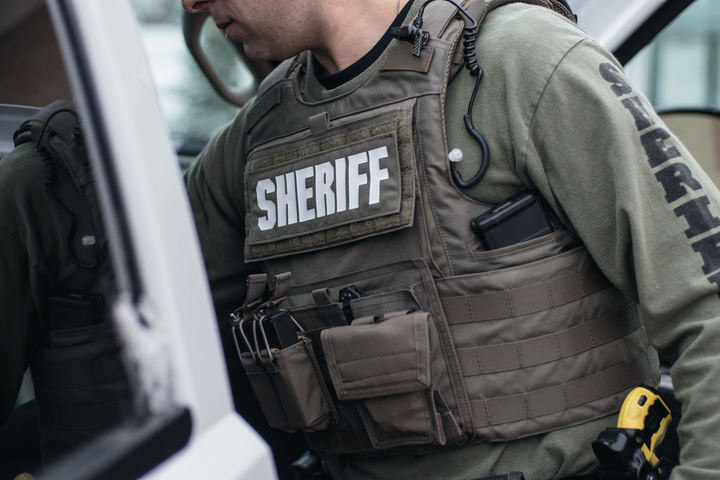
Sometimes the protective part and the holder are integrated together (namely soft bulletproof vests), but for the types of armor relevant to prepping, the plate and carrier are separate and often from entirely different companies.
Details about laws, armor basics and types, and full research on products below the fold. Summary:
- Soft armor (whether soft plates or soft vests) is only for knives, pistols, and shotguns. We mostly ignore this type, although it can be good for child backpack inserts or light and stealthy mild protection.
- For prepping, we want to protect against rifles, too. This means you buy hard armor that you insert into a chest harness (usually called a plate carrier).
- All armor is rated by level. The higher the level, the more types of ammo it protects against. All soft armor is level IIIa (i.e. “3 minus”) or below, and all hard armor is III, III+, or IV.
- Level III is not good enough because it can’t stop common AR-15 rifle rounds.
- Level III+ is the sweet spot for most people. Level IV is for serious preppers.
- Choosing body armor is about compromise and trade offs, such as protection vs. cost vs. weight vs. thickness.
- When evaluating armor, it’s not good enough to say things like, “this armor beats .223 ammo!” It depends entirely on the specific ammunition used, including how fast the bullet travels. We focus on M855 and M193 .223 ammo as the criteria for level III+.
- Hard body armor is heavier and more uncomfortable than you expect.
- The vast majority of people prefer curved plates instead of flat plates.
- Weight matters more than most people expect. The difference between 18 pounds and 11 pounds of armor is meaningful for untrained civilians in emergency scenarios.
- Full body armor is not worth it. Adding a helmet or side plates is fine, but many soldiers are going in the opposite direction, reducing their coverage area in order to be more nimble and comfortable.
- Never use steel armor without an anti-spall coating.
- Ceramic armor does not take as many hits and is not as durable as steel armor, but it’s not the fragile porcelain some make it out to be.
- The steel vs. ceramic debate is more of a personal preference at this point.
Great for most people |
|
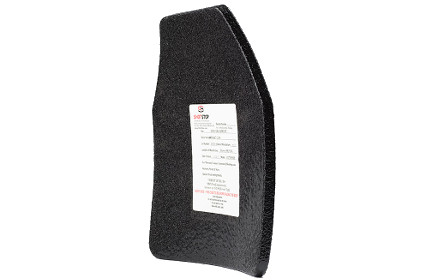 Light, thin, strong:ShotStop Duritium GT III+New entrant to the civilian armor market, but making a name quickly. Better than average weight and thickness for its class, at a reasonable price. Stops 95% of threats you'd face in a crisis.
shooter cut 10x12 |
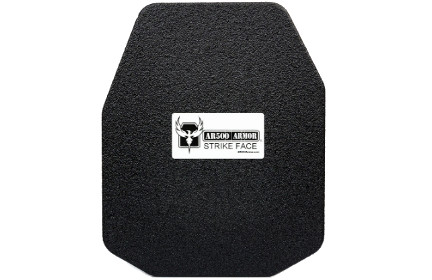 Best bang for buck:AR500 Advanced Shooters Cut Level III+Best bang for the buck. One of the most popular armor plates. Durable with 20 year shelf life. Stops 95% of the threats you'd expect in a crisis. Not as light or form-fitting as we'd like. Spall coating a must.
10"x12" multi-curve & build up coat |
If you care mostly about weight |
|
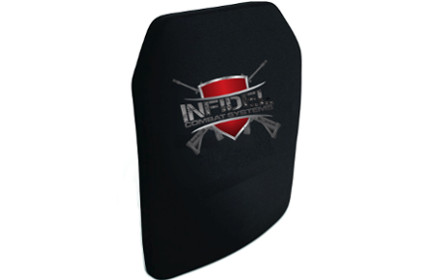 Infidel Lightweight III+95% threat coverage. Better than average weight and features for the price. Infidel is a popular armor company among preppers. 7 yr warranty.
|
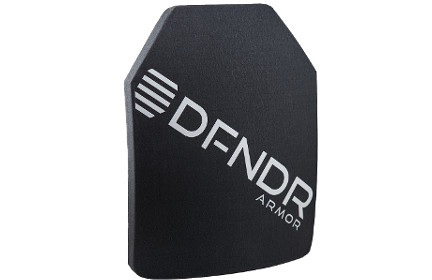 DFNDR III++Use 15% off code "theprepared2018". 95% threat coverage. DFNDR is new to the civilian market but has a long history. Pricey compared to peers, but a very light and comfortable option.
after 15% off code |
If you want the highest protection level |
|
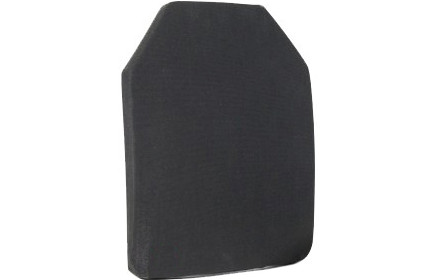 HighCom Guardian 4S17M IVWill stop 98% of threats you're likely to face. A popular plate from a well-known company. Often rebranded and sold by others, but available to buy from the original maker. 10 yr warranty.
10x12 shooter cut |
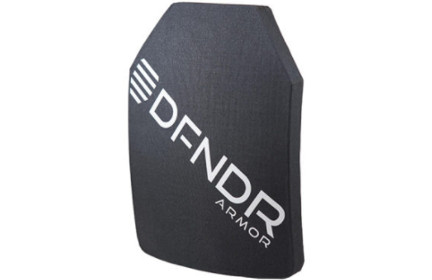 DFNDR IVUse 15% off code "theprepared2018". 98% threat coverage. Only available in SAPI sizes, not the common 10x12. Lighter than its peers with a nice multi-curve form factor.
after 15% off code |
- Why you should trust us
- Who should buy armor and why
- Body armor laws
- Bulletproof doesn't mean bullet proof
- Armor types
- Hard vs. soft & how does armor work?
- Stand alone vs. In Conjunction With armor
- Concealable vests vs. external combat plates
- What do threat rating levels mean?
- Most common gun threat data
- Which armor level is right for me?
- Materials: steel vs. ceramic vs. plastic
- Spalling and anti-spall coatings
- Which material type is right for me?
- Armor sizes and body placement
- Cuts: SAPI vs. shooter vs. swimmer
- Curved vs. flat plates
- Our criteria for picking the best options
- Top body armor choices
Why you should trust us
We spent just over 100 hours researching the world of body armor and considered over 240 different products. We compiled data on the top ~100 and picked the top 5-10 in each category.
We scoured product reviews and social forums, and interviewed manufacturers, self defense, and prepping experts.
The main authors have personally bought and used many of these products, including the top picks, for both personal prepping and military procurement.
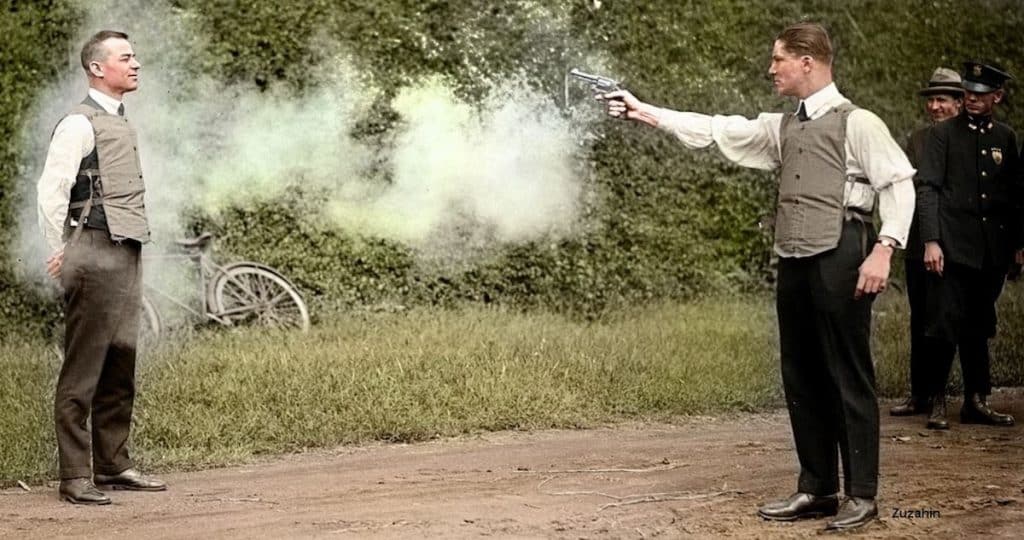
Reasons why civilians buy body armor
Civilian body armor purchases happen in a very different context than a professional security guard or solider.
Similar to gas masks in an emergency, a bulletproof vest does not make you Rambo. You don’t want to use it. If you do use it, things are bad. If you’re getting shot multiple times with high-powered rounds, things are really bad. It’s very unlikely you’re going to be out wandering the wastelands in full tactical gear, dominating fights left and right.
So why do people buy body armor?
- Safety during shooting practice. Many preppers not only like the added bulk when training to mimic a real scenario, but it provides extra protection when doing active/dynamic shooting drills since people are at risk of accidental discharges from tripping while running, etc.
- Home defense. You hear a bump in the night and throw on your vest before walking downstairs in your slippers and underwear (tactical bathrobe!)
- Bugging in / sheltering in place. Since the most likely place you’ll shelter when SHTF is your home, it’s easy to keep armor around for a variety of uses.
- Everyday carry and active shooters. Some like to keep armor in their backpack or EDC gear. For example, if an active shooter event occurs, you can swing your backpack around to protect your chest or use it as a door shield. Some parents buy it for schoolchildren.
- Patrolling and scouting. In a nasty scenario, you may need to defend an area or go out to scout for food. Armor can make a big difference.
Body armor laws
Civilians can buy body armor online in most areas of the US. Felons are prohibited from buying or using armor. Residents of Connecticut must make the purchase in-person.
There are no government background checks or ID records.
This guide focuses on armor available in America. Many of these products won’t sell or ship to international addresses. A growing number of vendors are checking IDs before shipping to verify citizenship.
The UK is similar to the US. Other EU states are much stricter. Some Canadian provinces (Alberta, BC, Manitoba, NS) require a security license to buy locally, although many report buying from the U.S. and bringing it home with no trouble. Australia has effectively banned body armor.
Banning body armor is one of those things that comes up in politics every few years, especially in states like New York and California. In March 2018, one chamber of the Chicago city government passed a body armor ban, but it doesn’t look like it will progress into law.
“Bulletproof” doesn’t actually mean bullet proof
People and movies often call armor “bulletproof vests” — but that incorrect label gives the wrong impression that armor is impervious to bullets. Similar to how the label “silencer” gives the wrong impression that a gun suppressor will make your shots silent or sound like the soft pew-pew noise in action movies.
Short of owning a tank, nothing you would realistically use is actually bullet proof. Every piece of armor can be defeated, whether it’s by an extreme weapon or simply from repeat shots of a common weapon.
Body armor types
Sometimes brand names, like Kevlar and Dragon Skin, get mixed up with armor classes. If it has capital letters, it’s most likely a brand.
All armor can be classified as either soft or hard, and as an integrated product or a separate “plate”.
When people refer to a bulletproof vest, they usually mean these all-in-one soft armor fabric vests:
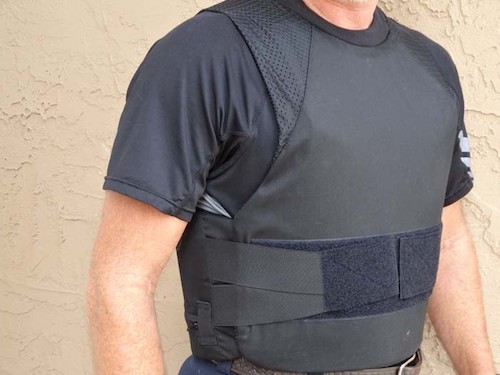
Armor plates are separate pieces that you slide into a pouch on a vest or chest rig, known as a plate carrier.
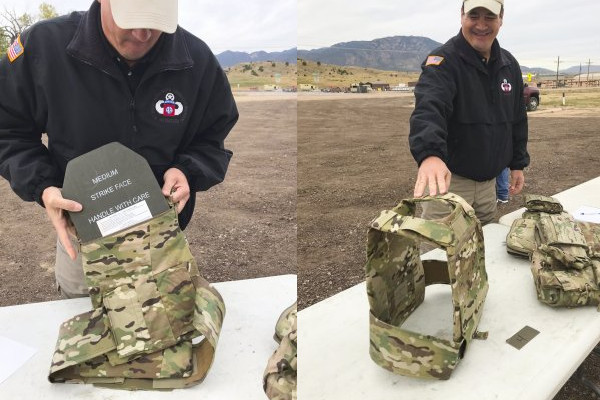
Those chest rigs not only hold the plate, but serve as a foundation for radios, lights, ammo, etc.
Plates can be hard or soft. Soft armor plates are often called inserts instead of plates. Both types are referred to as “ballistic” plates because they are meant to stop bullets.
Even if you’re wearing the toughest hard armor plate, getting shot will not feel good. So some people wear a soft trauma pad as a cushion between the armor plate and their torso.
Sometimes a soft ballistic armor insert and a hard armor plate are used together. Not just for the cushion of the soft insert, but to double up on the ballistic protection — like the “In Conjunction With” products below.
We think trauma pads are a good idea. They’re cheap and you can get them from most of the reputable companies, like this $35 10″x12″ pad from AR500 Armor.
Hard vs. soft armor & how does armor work?
In short, armor either catches or destroys the bullet while spreading the kinetic energy around a wide surface area.
We dig into threat level ratings below, but the easy answer is that soft armor is for knives, pistols, and shotguns, while hard armor adds protection for rifles and explosives.
Soft armor is a strong but flexible woven fabric net. It catches the bullet and absorbs the energy through the fabric weave, just like if you tried to poke your finger tip through your shirt.
Soft armor is more comfortable and can cover more area around your torso. But it has inherently less threat protection.
Most soft armor comes as an all-in-one vest form. But there are also standalone plates that are soft, meant to slide into a vest or backpack.
Hard armor plates (a.k.a. “tactical armor” or “military-grade armor”) are very rigid. In some cases it’s literally a steel plate made from the same material the military uses in light armored vehicles. It’s heavier, bulkier, uncomfortable, reduces your agility, and covers less area than many soft armor products.
But hard armor will protect you against significantly more threats, especially the types we plan for in emergencies. It works by shattering the bullet, like a car hitting a concrete barrier.
All-in-one “stand alone” plates vs. multi-piece products
Something new buyers often overlook is that some armor is designed to be used with multiple pieces.
Those products must be layered with a separate soft ballistic pad in order to provide the threat level rating they are certified against. Without the complete package, you are not fully protected.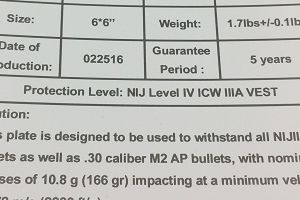 Because your prepping must be simple and practical, we recommend going with standalone armor rather than In Conjunction With versions.
Because your prepping must be simple and practical, we recommend going with standalone armor rather than In Conjunction With versions.
There aren’t really any advantages to the multi-piece versions. It’s more of a holdover from military procurement desires so they could swap one part instead of the whole thing.
The vast majority of armor in the market is standalone. But it’s not always clear which is which on product websites. The sticker label on the backside of the armor would say In Conjunction With or ICW. If the rating says “Level IV ICW IIIA”, it means that product only reaches level 4 if paired with another 3a armor product.
Concealed vests vs. external combat plates
Concealable armor is almost always soft armor, which lowers your threat protection level and exposes you to rifles.
Many concealable vests can be worn on the outside, too. On the other hand, hard armor is basically never worn concealed.
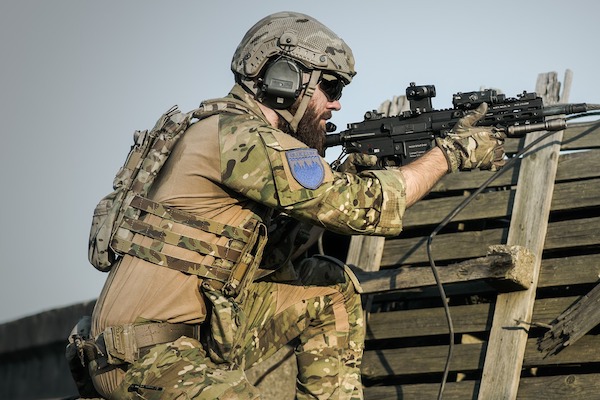
Concealed armor vests are still bulky and create weird “printing” lines in clothing. Don’t expect to speak face to face with someone without them noticing it under your T-shirt.
One veteran proclaimed, “If I’m on a scouting mission to a local store to salvage food for my family, I’m a lot more worried about people with a shotgun than people with a knife. It doesn’t matter if they can see I’m wearing armor or not. In fact, I’d probably prefer they can see that I am so it prevents them from attacking me to begin with.”
There’s a reason why street cops wear soft vests but warfighters wear external hard plates. Cops are mostly worried about random knives, broken bottles, and small pistols — the vast majority of their daily threats. Having more comfort and agility while constantly tackling suspects and getting in and out of your patrol car helps, too.
Combat soldiers wear external armor plates because they expect more fighting against rifles like AK-47s.
Combat veterans and survival experts aren’t unanimous, but most seem to agree that in a prepping scenario it’s better to protect against a wider range of threats even though it means wearing visibly obvious armor and bearing more weight. Plus the visible deterrent could scare away possible attackers.
Threat level ratings
When you start poking around these products, you’ll see labels like Level II, Level III, Level IIIa, Level III+, etc. What do these armor classes mean?
The DOJ’s National Institute of Justice sets the standards for body armor threat ratings. Each level represents tiers of specific threats, like a 9mm pistol shooting 124 grain bullets at 1,245 feet per second.
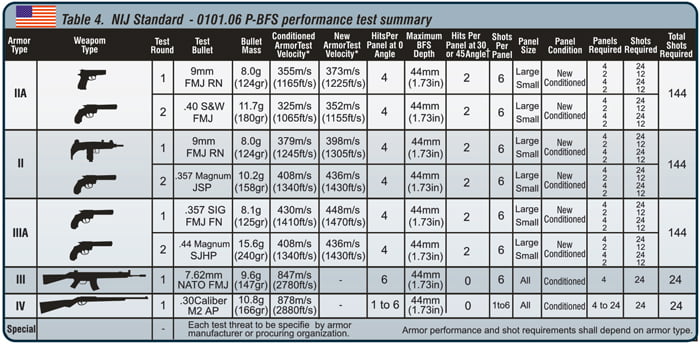
The reason why one bullet might defeat an armor plate when another bullet doesn’t comes down to the toughness of bullet material (e.g. copper vs. tungsten), bullet mass, and velocity.
Even gun barrel length can make a difference. The same exact round will go faster if shot from a 20” barrel than a 16” barrel. Armor might stop the bullet from a 16” barrel, but the 20” barrel shot will go right through.
Consider the difference in bullet size between the common AR-15 round (5.56mm / .223) and common hunting rifle ammo (7.62mm / .308):
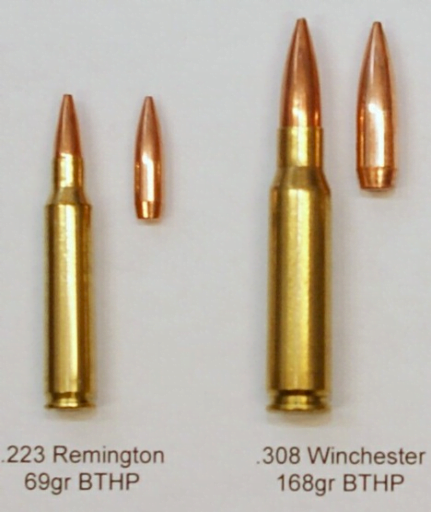
The NIJ standards are outdated, but they’re expected to be updated soon (to the .07 rules). But today it leaves a gray area, especially for the common rifle rounds that exist between level 3 and 4.
“Level 3+” is popular with current marketing and product trends. But you’ll notice that 3+ (or III+) isn’t a NIJ standard category.
The industry made improvements over the base level 3 category, namely by making plates that stop almost any type of common ammo (except for armor piercing .30-06), including faster “hot” .308 loads and M193/M855 “green tip” .223 AR-15 ammo.
In the meantime, a few companies have (sort of) settled on that common marketing language as a way to communicate what they can do.
But that also makes it ripe for fraud and shady marketing tactics, such as claiming a plate is level 3+ because it can stop M193, but when you dig into the data, they used a very slow M193 round (2,700 fps instead of 3,100 fps) in a dishonest and unregulated test.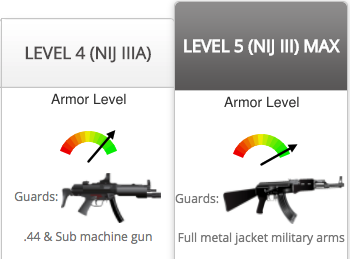
There is no such thing as level 5 body armor. eBay listings and YouTube videos claiming otherwise are lying to you, or using dirty tricks, such as labeling armor “Level 5 (NIJ III)” to confuse you.
Knife ratings are quite different. The NIJ doesn’t test for slashing motions, since almost any armor will defeat a standard slash.
The real concern is stabbing on soft armor, since pointy tips (like the end of an ice pick) can work their way into the tiny gaps of the fabric net and push their way through. The testing is convoluted, but you’ll want to look for level 1 or level 2 “spike” protection. Higher is better. All of the armor we recommend below is good enough.
Most common threats and armor piercing ammo
We really wanted to dig into the ammo sales data deeply enough to show charts that say “level 3 defeats 87% of all the bullets in America”.
Unfortunately the data isn’t specific enough to do that, because while we can find sales data by ammo type (.223, .300 WIN MAG, etc.), we can’t break it down by velocities or special bullet materials — the two factors that would make a difference on beating different armor levels.
Ammo sales volume data averaged across multiple sources over the last few years:
| Round (gun type) | % of sales volume |
|---|---|
| 9mm (pistol) | 19.3% |
| .223 / 5.56 (rifle) | 15.2% |
| .45 (pistol) | 10.6% |
| .22 (pistol/rifle) | 8.3% |
| 12 ga (shotgun) | 7.9% |
| .40 (pistol) | 6.7% |
| .308 / 7.62×51 (rifle) | 4.7% |
| .380 (pistol) | 4.2% |
| 7.62×39 (rifle) | 3.9% |
| .357 (pistol) | 3.1% |
| .30-06 (rifle) | 1.9% |
Those top 11 rounds represent 85% of the overall market. Once you get past those, sales volume drops a lot among the 100+ other calibers on the market.
An example problem is knowing how much of the .223 rounds (which represents ~15% of all ammo in America) is normal .223 versus special .223 with armor penetrating tips or higher velocities. So we’re making educated guesses based on our experience.
If we reorganize by armor class, what is your chance of having the right armor to defeat an attack by a random person in the US during an emergency?
| Armor class | Survival chance |
|---|---|
| Level 2a | 35% |
| Level 2 | 40% |
| Level 3a | 60% |
| Level 3 | 70% |
| Level 3+ | 95% |
| Level 4 | 98% |
Keep in mind that ammo will improve over time, so where a level 3 plate is 70% in the table above today, 15 years from now it might be 60%.
“Armor piercing” ammunition is growing in popularity, and new tech is turning ammo that was commonly defeated by hard armor into hole-punching nightmares.
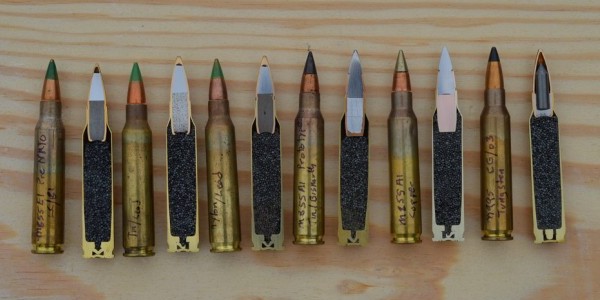
Within the world of AR-15 ammo (.223 / 5.56), a level 3 plate will defeat most vanilla .223 rounds. But there are two relatively-common .223 rounds, M193 and M855 “green tips”, that will defeat most level 3 plates.
M193 travels fast (~3,150 fps), so it usually penetrates level 3 steel. On the flip side, M855 is slower (~2,950 fps) but has a harder bullet core, so it usually penetrates level 3 ceramic / polyethylene. It’s just how the materials work.
Which is why they created level 3+ plates. A true 3+ plate can stop almost all .223 ammo, including M193 and M855.
However, a new version of the old green tips, the M855A1 EPR, was designed by the military with a steel penetrator core specifically to defeat any steel armor. And it does:
Those kind of rounds are very rare today, but they and others like them will become more common in the next decades.
What body armor level is best for me?
For hard armor we recommend either level 3+ or level 4, and think level 3+ is the right class for most people when you consider things like cost.
Why? Normal level 3 body armor does protect against the majority of threats you’ll face, but it’s borderline, and there’s a meaningful chance you run into something that would beat it during an emergency — namely hunting rifles or AR-15s shooting common M855 “green tips” or M193 ammo.
Level 3+ is only slightly heavier (~0.5 lbs) and not much more expensive (~$30). So if you’re going to wear hard armor, you may as well do that little bit extra to get a lot more protection.
This video shows a .30-06 round going through an AR500 level 3, but not through a level 3+:
The jump up to level 4 body armor is a matter of personal choice. If you want the best protection possible or specifically care about protection against very high powered or armor piercing rounds (like the uncommon .30-06 AP black tip), go level 4.
Just know that level IV gets more expensive and you end up carrying roughly the same weight as a steel level III+ plate.
You don’t see level 4 steel plates because they’d be too heavy to be practical (~15 lbs). But the first steel/ceramic hybrid level 4s are hitting the market in 2018.
Don’t ever buy steel armor outside of a reputable company we cover here. For example, some random people will DIY a “level 4 steel plate” out of home-cut sheets of steel and sell them at gun shows.
If you don’t care about that much protection and/or really want soft armor, then we suggest the maximum, level 3A. The jump up in protection compared to the level 2 is worth it for threats like 12 gauge shotguns.
You might see other articles/videos with different opinions. Many police and security guards reasonably think level 2 soft armor is fine, for example. Yes, a street cop would be fine with level 2 because the vast majority of their threats are knives and common pistols like 9mm and .40 S&W. But keep in mind they have very different contexts than you do as a prepper.
Steel vs. ceramic vs. UHMWPE plastic
Hard amor is made of one or more of those three materials: steel, ceramic, and plastic. Sometimes, when it’s a mix of materials, it’s called composite. Each one has its pros and cons.
Steel:
- Cheapest
- Thinnest
- Heaviest
- Most durable, both on the shelf and taking multiple hits
- Creates spalling, a form of dangerous bullet shrapnel, which requires a special coating around the steel to catch the bits
- Usually stops M855 green tip ammo, a common AR-15 round, but not the other common round, M193
Ceramic:
- Most expensive
- Thickest
- Lighter
- Less durable, short shelf life
- Typically better at stopping more extreme bullets than steel, but it can’t stop as many bullets as steel and will fall apart after being hit a few times
- Usually stops M193 ammo, a common AR-15 round, but often won’t stop the other common round, M855 green tips (it depends on specific materials, like Boron Carbide vs. Alumina)
UHMWPE (Ultra High Molecular Weight Polyethylene) plastic:
- In between steel and ceramic on things like cost and durability
- Lightest, even floats in water
- Takes about the same number of hits as ceramic, but the back face deformation is more prominent
- Certain rounds, namely the common M855 green tip, will almost always beat UHMWPE
Spalling and the importance of anti-spall coatings
If you buy steel armor plates, you must get the anti-spall coating! Ceramic doesn’t have this issue, so it’s moot.
When hard armor stops a bullet, it doesn’t pulverize the bullet into dust or catch it whole in one piece.
The bullet shatters into many smaller pieces, called spalling, that still have enough energy to do damage. That shrapnel can destroy your neck, chin, and arms.
This video is about using spalling to your advantage (for advanced warfighters) but clearly shows how spalling off of steel will hit the cardboard to the side:
Companies have essentially overcome this problem with extra anti-spalling coatings around the steel. It acts like a sponge buffer that traps the fragments after impact. The material is similar to aftermarket spray-on truck bed liners.
This video from AR500 Armor shows how effective the coating is:
The industry is still advancing in this regard. You’ll notice in some video reviews that when shot, the coating layer will split away from the steel. We dislike this a lot, and it’s one of the qualities we judge against when reviewing armor.
Which armor material type is right for me?
There’s no singular right answer. The armor you can afford to buy and use is better than the luxury armor you never own.
In our opinion, for your average civilian just trying to get ready for emergencies, it’s better to get more complete threat protection in a durable plate even though it weighs more. So if we have to choose, we recommend steel, especially since it’s half the cost of other materials.
Many of the popular armor testers on YouTube are also leaning towards steel over ceramic.
But when we polled prepping experts and elite military operators, the general consensus is that they prefer ceramic. But it’s more of a 60% vs. 40% thing, not a strong pounding-fists-on-the-table debate, and might be swayed by the all-ceramic military context.
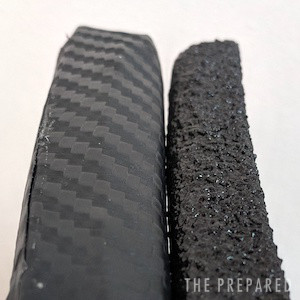
Ceramic plates can be 2-3 times thicker than equivalent steel plates (0.5 vs. 1.0 inch). But steel plates can be 2-3 times as heavy (4 vs. 9 pounds).
Most people are not in good enough physical shape for SHTF scenarios, like walking for miles with their bug out bag and armor on. Does that mean there’s no practical difference between carrying 72 and 78 pounds? Or does that mean every pound matters even more?
Some argue that the meaningful weight savings with ceramic will help a normal person better survive — since they aren’t trained warfighters and can’t move well in a fight — so extra agility and stamina is even more important.
Ceramic and plastic don’t have spalling issues of steel because the material splinters when it stops the bullet, catching the little fragments.
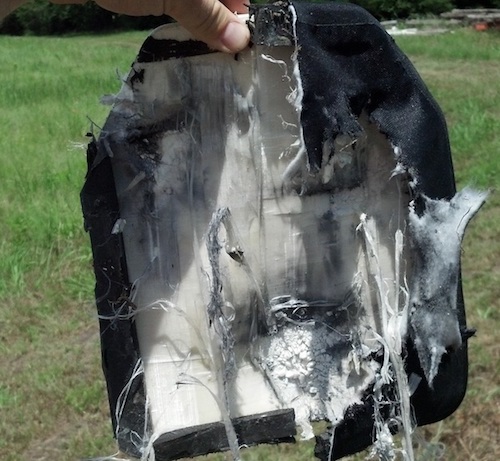
But this leads to many criticisms against ceramic armor. Because it splits and shatters, it won’t hold up against as many repeat hits as steel will.
There are no concrete numbers — it depends on lots of factors, like a bullet hitting the same spot twice — but a ceramic plate might fail after 5 hits, where an equivalent steel plate might fail after 20.
Ceramic:
Steel:
Some will argue that if you’ve been shot more than five times, things are really bad anyway and it doesn’t matter.
Another argument is that in a true SHTF situation, since you can’t get new plates, if you only have one plate it should be one that takes as many hits as possible. When a ceramic plate is hit, that area is effectively worthless afterwards. But a steel plate can keep taking hits in the same area.
Sometimes you can ruin an expensive ceramic plate just by dropping it on hard ground, or even by letting it bake in the sun in a hot car.
But the way some people talk about ceramic armor on the internet makes it seem like fragile porcelain, which is an over exaggeration. This (shaky) video shows a ceramic plate being hit with a sledgehammer and still working afterwards:
On the other hand, steel is extremely durable. Here’s AR500 running over it with a forklift:
In the end, it’s up to you. That’s why our recommendation for serious preppers is a mix of both types!
Body armor sizes and how to wear
Armor sizes are not like clothing sizes, and in many cases you can’t return armor once you’ve received it because the company has no way of knowing if you’ve compromised the integrity of the armor (especially ceramics).
Bullet proof vest sizing is more complicated because it’s more of a snug-fitting garment, and people are very diverse in their body shapes. Check with whatever manufacturer you end up buying from. Example video.
Hard and soft plates are much easier.
The military uses ESAPI plates, which have standard sizes. Many private companies follow their lead. But many civilian-oriented companies, like AR500, use non-military sizes.
This mostly matters when pairing a plate with a plate carrier. A civilian medium plate won’t match a military medium carrier, etc. Putting a 10”x12” plate in a carrier designed for 9.5”x12.5” plates causes more problems than you’d expect.
ESAPI sizes:
| Size | Dimensions (inches) | Male chest size (ballpark) |
|---|---|---|
| Extra Small | 7.25 x 11.5 | < 36 |
| Small | 8.75 x 11.75 | 36-38 |
| Medium | 9.5 x 12.5 | 38-42 |
| Large | 10 x 13.25 | 42-44 |
| Extra Large | 11 x 14 | 44-48 |
The alternative sizing you see from civilian-oriented companies:
| Size | Dimensions | Reference |
|---|---|---|
| Extra Small | 8 x 10 | Most women |
| Small | 8.75 x 11.75 | Large women / petite men |
| Medium | 10 x 12 | Most men |
| Large | 11 x 14 | Largest men |
The majority of you will buy either 10” x 12” or 9.5” x 12.5”.
Many people go too big. It’s important that while wearing armor you can still move, hold a pistol in a proper stance, shoulder a rifle, and sit down without the bottom of the armor hitting your belt/lap.
The actual product you receive probably won’t match the exact dimensions ordered. A 10 x 12 plate may arrive as 9.8 x 11.7, or it might be a fraction bigger.
We tend to see them slightly smaller than labeled — which is better than the vice versa — but can result in the plate sitting too low as it sits in a plate carrier pouch intended for a taller plate.
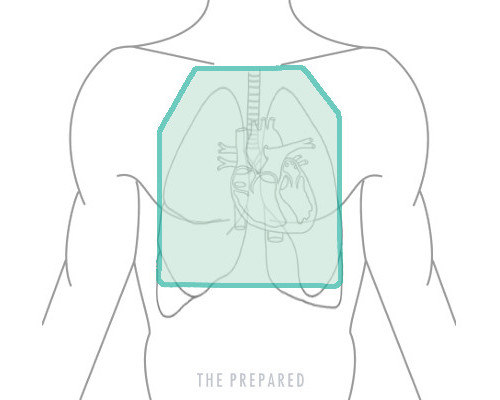
Plates are only intended to cover your vital organs — namely heart and lungs, and some of your liver, kidneys, etc. that tuck under your ribs.
Don’t ride your armor low. The top of armor should touch your sternal notch — that’s the hard junction where your two collar bones meet in the middle, and you can feel it with your fingers. Plates will normally end around the bottom of your lungs or rib cage.
SAPI vs. shooter vs. swimmer cuts
We recommend shooter cuts.
Companies are experimenting with different form factors to improve comfort, such as cuts and curves. Cuts refer to the outline shape of the plate:
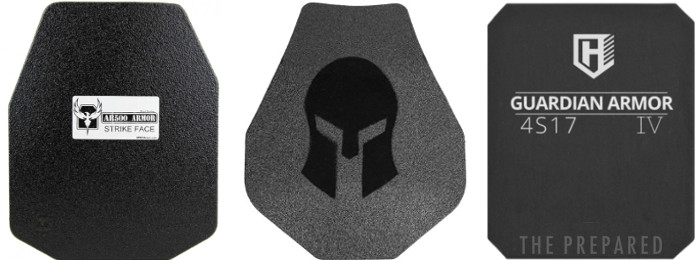
- Rectangular: Sometimes good for protecting your back.
- SAPI: The top corners are clipped down.
- Shooter: More aggressive cut down top corners, like the left plate above.
- Swimmer: Most aggressively cut down on all corners, like the middle plate above.
Rectangular plates are sometimes used for your back. But many plate carriers won’t hold them in either the front or back due to how the fabric cavity is cut, meaning the rectangular plate won’t fit inside.
SAPI, shooter, and swimmer cuts are just clipped down corners. The difference is how extreme the cut angle and depth is.
The more material clipped off the corners, the lighter the plate and the more you can move. This is how some manufacturers turn a normal plate into a “lightweight” version — simply by clipping off more of the material.
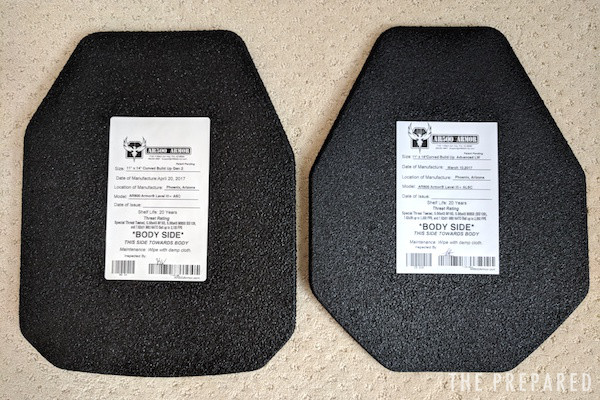
Think about how you hold a pistol or shoulder a rifle/shotgun. Your arms come up and your shoulders roll forward. These cuts give your arms/shoulders more room to move, and in some cases give you more space to shoulder a weapon.
In the picture above, the left plate is a right-handed shooters cut. You can tell because the right arm side (on the right from our view, since we’re looking at the back of the plate) is cut more aggressively than the left, creating more shoulder / buttstock room.
In our opinion, if you wear a plate that’s properly sized and positioned, a normal shooters cut provides enough room to move and shoulder without sacrificing too much coverage.
Curved vs. flat armor
Carrying a flat steel plate on your round chest is obviously less comfortable than a curved plate.
Armor can curve from belly to neck and from shoulder to shoulder. And there are some unique or aggressive curve patterns:
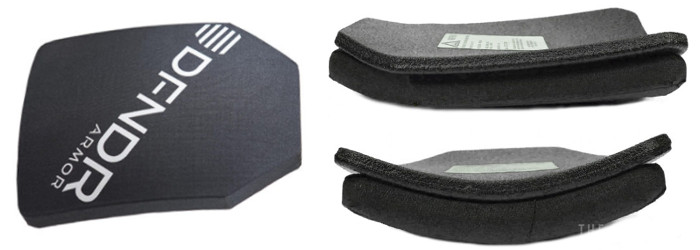
You’ll see marketing language like “single curve”, “multi-curve”, and “triple curve”. Single curve plates wrap horizontally, as if the crease was vertically down the middle, hugging from your left to right side.
Multi-curve plates add at least vertical curve, so the top will curve inward a little bit above your pecs or breasts. Beyond that, extra curves and tweaks are a manufacturers attempt to make the plate as body-hugging as possible.
Some companies, like CATI and Premier, are getting really bendy with their armor. We love the experimentation. But know that the more severe bends put in a steel plate, the weaker it gets, so the industry is limited in what it can do.
For your back plate, it’s more a matter of personal preference. If you have a more rounded back, consider a basic curve. If you’re average or fit, some people think flat back plates are fine (or even preferred).
Consider how the plate curve will work in your carrier. A plate that’s too flat can create an odd shelf at the top, where the plate sticks out away from your sternal notch. A plate that’s extremely curved can make things awkward, especially for MOLLE accessories attached to the front.
How to buy body armor for sale
The industry is kind of a mess for civilians. Many manufacturers won’t sell to people without a military or law enforcement ID. Product names and numbers are often missing or wrong.
It’s difficult to find product info, and even harder to find accurate and complete product info.
Considering these are life-saving products, we’d like to think a product listing page on a popular armor website would have correct descriptions of things like which threats it will protect.
But unfortunately, we caught way too many errors during this work. For example, a 3A plate (which is not rated for rifles at all) was being sold as a 3+ plate. We notified the companies when we found these errors, and about half made the needed updates.
When you see “XYZ Brand” armor, many times it was made by one of a few core companies and rebranded to sell to civilians. Companies like LTC, Hesco, HighCom, and TenCate make great armor for military and law enforcement, then sell white-labeled versions to the brands you’re more familiar with for resale to the public. We’ll often see people arguing in prepper forums about whether XYZ or ABC plate is better, when in fact they’re the exact same plate.
Our desired criteria:
- At least level 3+, meaning it can defeat normal .308 in addition to .223 M855 at 3,000 fps and M193 at 3,100 fps. That covers the vast majority of common rounds, like those from a 16” AR-15 at home defense distances.
- NIJ-rated or trusted equivalent, with real-world threat test reviews.
- Reasonable cost for normal people, which disqualified most plates over $500.
- As light and thin as possible compared to peers.
- Shooters cut, curves, and thick anti-spall coating (only needed on steel plates).
- Works on its own (“stand alone”), no ICWs.
- We strongly favor companies that respect civilians: Well-built ecommerce experiences, clear info on warranty and exchanges, able to buy one plate at a time, or has robust reseller relationships if they don’t normally sell directly to civilians (Hesco, LTC).
- We strongly favor companies that present clear, honest, well-organized products and information. For example, a clearly branded 3+ plate with specific NIJ and ballistics data (including velocities) shown on the product page, rather than murky product listings with ambiguous data (“stops green tips!”) or buried hoops to jump through.
In short, we like companies that make it easy for you to quickly and comfortably buy the right thing — unfortunately, many in this industry don’t.
To narrow down our recommended choices for the best plates, we considered over 240 different armor products and collected deep data on ~90. The top ~5 per category are listed below. Top choices are green in the spreadsheet, yellow are close contenders.

